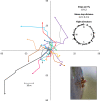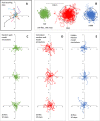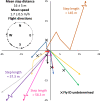Tracking and modeling the movement of Queensland fruit flies, Bactrocera tryoni, using harmonic radar in papaya fields
- PMID: 39080311
- PMCID: PMC11289093
- DOI: 10.1038/s41598-024-67372-4
Tracking and modeling the movement of Queensland fruit flies, Bactrocera tryoni, using harmonic radar in papaya fields
Abstract
Determining movement parameters for pest insects such as tephritid fruit flies is critical to developing models which can be used to increase the effectiveness of surveillance and control strategies. In this study, harmonic radar was used to track wild-caught male Queensland fruit flies (Qflies), Bactrocera tryoni, in papaya fields. Experiment 1 continuously tracked single flies which were prodded to induce movement. Qfly movements from this experiment showed greater mean squared displacement than predicted by both a simple random walk (RW) or a correlated random walk (CRW) model, suggesting that movement parameters derived from the entire data set do not adequately describe the movement of individual Qfly at all spatial scales or for all behavioral states. This conclusion is supported by both fractal and hidden Markov model (HMM) analysis. Lower fractal dimensions (straighter movement paths) were observed at larger spatial scales (> 2.5 m) suggesting that Qflies have qualitatively distinct movement at different scales. Further, a two-state HMM fit the observed movement data better than the CRW or RW models. Experiment 2 identified individual landing locations, twice a day, for groups of released Qflies, demonstrating that flies could be tracked over longer periods of time.
Keywords: Directional movement; Field tracking; Fractal analysis; Hidden Markov models; Modeling; Movement simulation.
© 2024. This is a U.S. Government work and not under copyright protection in the US; foreign copyright protection may apply.
Conflict of interest statement
The authors declare no competing interests.
Figures








References
-
- Miller, N. D., Yoder, T. J., Manoukis, N. C., Carvalho, L. A. & Siderhurst, M. S. Harmonic radar tracking of individual melon flies, Zeugodacus cucurbitae, in Hawaii: Determining movement parameters in cage and field settings. PLoS ONE17, e0276987 (2022). 10.1371/journal.pone.0276987 - DOI - PMC - PubMed
-
- Sonleitner, F. & Bateman, M. Mark-recapture analysis of a population of Queensland fruit-fly, Dacus tryoni (Frogg.) in an orchard. J. Anim. Ecol.32(2), 259–269 (1963).10.2307/2539 - DOI
-
- Chapman, M. Experimental analysis of the pattern of tethered flight in the Queensland fruit fly. Dacus tryoni. Physiol. Entomol.7, 143–150 (1982).10.1111/j.1365-3032.1982.tb00282.x - DOI
-
- Batsleer, F. et al. The neglected impact of tracking devices on terrestrial arthropods. Methods Ecol. Evol.11, 350–361 (2020).10.1111/2041-210X.13356 - DOI
MeSH terms
Grants and funding
LinkOut - more resources
Full Text Sources

